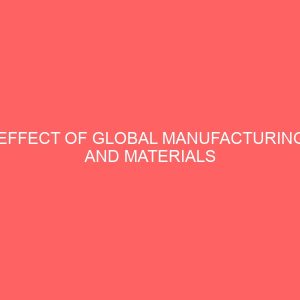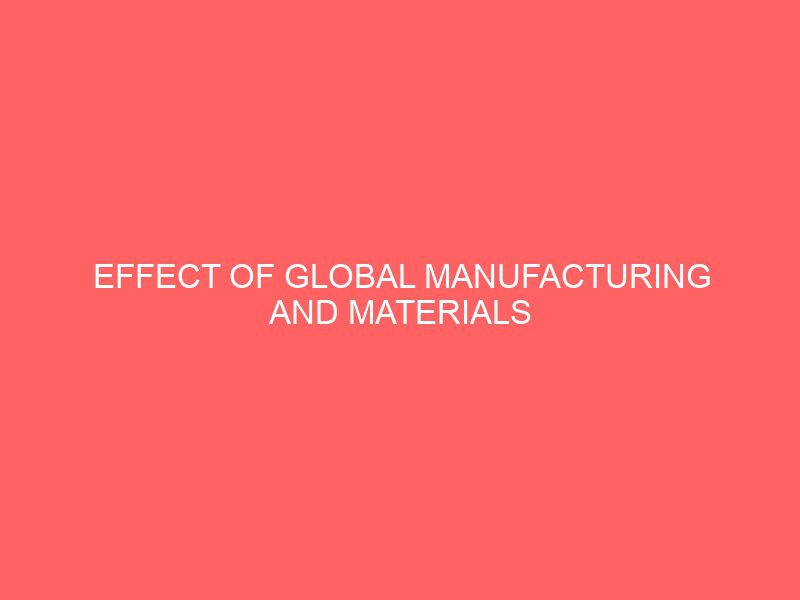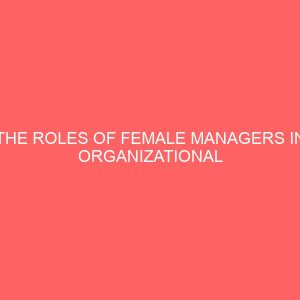Description
CHAPTER ONE INTRODUCTION 1.1 Background of the Study The history of globalization dates back to the era of mercantilism in the 19th and 18th centuries (Ogiji and Irem, 2010). The global effect of manufacturing and materials management has been felt on Nigeria business competitive position from the time of the early influences, to the time of independence and establishment of the Central Bank of Nigeria in 1960 till date. In 1946, the Nigerian Breweries Plc was first established in Nigeria (Nigerian Breweries Plc Report, 2011). This was also the year the first Pre-independence colonial development plan was done; it lasted for ten years till 1956. It was fully funded by the British colonial government. Its objective was to co-ordinate and increases the colonies? production of primary commodities and raw materials essential to the war effort (Shell Annual Report, 2008). In the 1950s, the techniques of Operations Research which were developed in 1945 during the second war were applied in materials planning aspects of Linear Programming (Taha, 2008). In 1960 which was also the year of Nigeria?s Economic Independence, the Central Bank of Nigeria was established to regulate banking activities in Nigeria which idea has developed since 1891 and the first Commercial Bank namely the Bank of British West Africa was established in 1894 which metamorphosed to the present First Bank of Nigeria. It is the responsibility of the Central Bank of Nigeria to formulate monetary policy and regulate global banking activities in Nigeria (Adekanye, 2008). Between 1962 and 1985 there were four Post Independence Development Plans but unfortunately none of the plans had the objective of getting a global effect of manufacturing and materials management on Nigeria business competitive position. In 1972 and 1977, there were indigenous decrees called the Nigerian Enterprise Promotion Decrees. They were aimed at transferring the ownership of many local and foreign owned enterprises from foreign to local hands. The Federal Government of Nigeria acquired 60% shares in some foreign owned banks (Ejiofor, 2008). There are now such applications such as computer aided manufacturing and computer aided design. For manufacturing, the breakthrough has been in materials requirements planning system (Unyimadu and Ugwu, 2008). From the 1970s till date, the Nigerian budgets have been dependent on crude oil exports. The early 1980s have marked a watershed period in the development of operations management aspect of materials management. There was the need for U.S. manufacturers to become more productive in order to meet the stiff competition from Japan (Unyimadu and Ugwu, 2008). This has led operations management and materials management specialists to become heavily involved in the applications of new technologies of flexible manufacturing systems and computer-integrated manufacturing and new manufacturing technologies. The strategic initiatives in the 1990s have also been in the areas of Just-In-Time (JIT) production and Total Quality Management (TQM). There has also been an emphasis in the area of production and material planning and control (Nahmias, 2008). Investors or manufacturer looks forward for a positive effect on global method of manufacturing, planning, purchasing and control, looks also for those important factor inputs such as: men, materials, money, time, energy, knowledge, information and infrastructure to enable him achieve positive business competitive position than his competitors. By men is meant the human resource. It is the most important resource in the sense that most of the other resources are inert in nature and it is only the human resource that can galvanize them and get them to go into production. Human resource management is the totality of the management of the abilities and competences of workers at work. It is a new aspect of personnel management; so human resource management includes personnel management, industrial relations management and employee welfare management. It has such important activities as recruitment, selection, placement, orientation, training and development, wage administration and motivation of the staff (Drucker, 2000). Materials have not always been so vital. In the management sense, materials became important around the 1900s. Before then, they were rightly taken for granted; as they presented no significant problem in either availability or cost. The place of the purchasing of materials in business can be seen more clearly after exploring the reasons for the shift in the relative importance of the five Ms (Lee and Dobler, 2000). During the first hundred years of the industrial system, productivity increased very little. The availability of manpower and horse power exceeded machine power almost one hundred times. The relationship started to change after 1850, nearly 100 years after the industrial revolution started in Great Britain. Between 1850 and 1950, an unbelievable increase in productivity took place. In 1850, productive power was divided as follows: 2 percent machine power and 98 percent horsepower and machine power (Heinritz and Famel, 2001). Because manpower was the first source of productive power, the initial industrial emphasis was on men or the human resource. As machines became more productive, the emphasis shifted towards them. As new products, specialized labour and materials distribution became more complex, the emphasis shifted towards Scientific Management which was at its peak in 1911 when Frederick Taylor published his book on scientific management (Lee and Dobler, 2000). Still later as both the complexity of materials and the volume of production skyrocketed, materials became a much larger element of cost. Emphasis shifted to materials before 1900, both the industrial machines and the items they produced were relatively simple. The manufacturing process was uncomplicated and low. Materials and components of production were simple, readily available cheap. Distribution of materials was restricted to a limited area. In fact a prerequisite for production for a hundred years was the location of plant near plentiful and cheap raw materials market. Other schools of thought in plant location were to locate near the product market or to locate some where in between the raw materials market and the product market (Banjoko, 2000). The perquisite of locating the plant near the raw materials market in limited area of distribution or the market within these constraints, labour costs represented the major portion of the production expense. The introduction of better machines coupled with scientific management to develop and utilize more sophisticated man machine systems. 1.2 Statement of the Problem In Nigeria, manufacturing has challenges of which the selected institutions in the South east Nigeria experienced global effect on Nigeria business compared to countries on international business competitive position. In Nigeria (in South East), businesses experienced a lots of challenges. The non-clarity of the uses and functions of the four important elements of materials management have effect on the global business competitive position of the selected institutions in South East Nigeria which is the subject for investigation. The four important elemental challenges are those of purchasing and production, inventory control, storage and warehousing and physical distribution. The challenging effect of electronic procurement on the availability of exportable goods that is very essential in competitive position on those institutions under study need to be investigated. It is important to note that most of the firm businesses in South East Nigeria are more on crude oil exports than non-oil products which should increase their business competitive position. Institutions in manufacturing and materials management are faced with the challenges of manufacturing planning and control, materials management, purchasing and production. Manufacturing and materials management seemed to have a positive global effect on import competitive position of the selected institutions. However, to cope, proper controlling, planning and measurement of manufacturing performance need to be done so that imports will not exceed exports, for a negative foreign reserve. There does not seem to be a positive effect of foreign direct investment on the business competitive position in those selected institutions in south east Nigeria. An investigation of the capital and irregular power supply in Nigeria that made things worse has that at the end of the day, foreign manufacturing firms such as Michelin, Dunlop and Unilever decided to relocate to Ghana from where they manufacture products and sell to Nigeria. It has therefore become imperative to look into global manufacturing and materials management and the effect it has on business. This has become necessary because of the increasing rate of dumping and manufacturing of low quality goods by firms in south east Nigeria.







